Posted by Elena del Valle on June 4, 2007
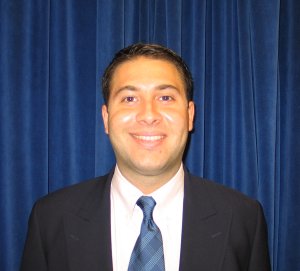
Federico A. de Jesús, director, Hispanic Communications
U.S. Senate Majority Leader Harry Reid’s office
Photo: Federico A. de Jesús
A podcast interview with Federico A. de Jesús, director, Hispanic Communications, U.S. Senate Majority Leader Harry Reid’s Office, is available in the Podcast Section of Hispanic Marketing & Public Relations, HispanicMPR.com. During the podcast, Federico discusses immigration reform issues with Elena del Valle, host of the HispanicMPR.com podcast.
Since March 2006 he has worked as spokesperson for Hispanic issues on behalf of the Leader and Senate Democrats. In 2003, he worked as press advisor for Hispanic Media Outreach for House Democratic Leader Nancy Pelosi in Washington, DC. During that time, he helped coordinate, draft and market the Democratic Hispanic Agenda Compromiso Demócrata con el Pueblo Latino, which was unveiled as the joint House/Senate Democratic vision for Hispanic American families.
In 2002, he was legislative correspondent, staff assistant and internship coordinator at Congressman Eliot Engel’s Washington, DC Office. Federico received a Bachelor’s degree from the School of Public Affairs at American University in Washington, DC.
To listen to the interview, scroll down until you see “Podcast” on the right hand side, then select “HMPR Federico A. de Jesús,” click on the play button below or download the MP3 file to your iPod or MP3 player to listen on the go, in your car or at home. To download it, click on the arrow of the recording you wish to copy and save to disk. The podcast will remain listed in the June 2007 section of the podcast archive.
“Emotional Branding: How to capture the heart and mind of the Hispanic consumer” audio recording


“Emotional Branding” was recorded January 2007 during the Strategic Research Institute 13th Annual Blockbuster Marketing to U.S. Hispanic and Latin America conference in Miami, Florida.
Receive a free downloadable copy by completing our Visitor Survey.
Click here
Click the button to hear the podcast:
Click here to sponsor a HispanicMPR.com podcast
Posted by Elena del Valle on May 30, 2007
Nilda Velez, vice president and general manager, MosaicaMD
Photo: MosaicaMD
New York, New York — MosaicaMD launched the first Spanish language radio advertising campaign for Kimberly-Clark Corporation’s Scott bath tissue. Although company representatives declined to disclose results so far, specific budget numbers, percentage of the overall campaign the new effort represents, campaign end date or exact media placements, they indicated this campaign increases their investment in strategic advertising and marketing programs targeting Hispanics.
“As a global billion dollar brand, it is extremely important for us to communicate the qualities Scott Brand offers that address the needs of the Hispanic market,” said Jody Douglas, advertising development manager, Kimberly-Clark. “As research shows, this market already holds the Scott Brand in high esteem and wants to make the best purchasing decisions for their families. Our continuous commitment to providing families’ good value and quality solutions makes the Scott Brand product line a perfect fit for Hispanic shoppers.”
Kimberly-Clark marketers hope the campaign will influence budget conscious Spanish speaking consumers. Their qualitative research indicates these consumers seek value and brand benefits; and that although Hispanic consumers may hold the Scott brand in high regard, some Hispanic consumers describe themselves as “Grab and Go” bath tissue shoppers whose initial purchasing decisions are usually based on trial and error and word of mouth.
The campaign is earmarked to air on Univision Radio in key Hispanic markets. Two 60-second spots began airing April of this year. The first was titled “Long Lasting” in support of Scott 1000 bath tissue; “Decisions,” for Scott Brand Extra Soft bath tissue, followed.
“We are pleased to be instrumental in this newest initiative targeting the Hispanic market and while we worked under very aggressive timelines, we’re proud of what we were able to accomplish and the end-result,” said Nilda Velez, vice president and general manager, MosaicaMD. “MosaicaMD has had a long working relationship with Kimberly-Clark having most recently adapted the Kleenex Brand facial tissue ‘Let It Out’ campaign to Spanish language TV and print. We look forward to continuing to be a resource for them in targeting this very important consumer segment.”
Kimberly-Clark has a presence in more than 150 countries. Company brands include Kleenex, Scott, Huggies, Pull-Ups, Kotex and Depend. In addition to Kimberly-Clark, MosaicaMD offers multicultural marketing strategy and creative services to clients such as Unilever/Best Foods, Johnson & Johnson and Citibank. The agency is a wholly owned WPP company.
Discover how to reach Latinos in language today with
“Hispanic Market Translation Issues” audio recording

Presenter Martha E. Galindo
Translation company owner Martha E. Galindo explains
-
Why it’s important to reach your clients in language
-
Ins and outs of translations issues
-
How to select a translator
-
What to expect
-
How to save on translation costs
-
Much more
Click here to purchase Hispanic Market Translation Issues
Posted by Elena del Valle on May 29, 2007
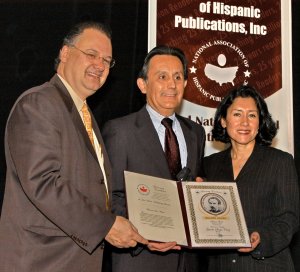
National Association of Hispanic Publications
Jose Marti Publishing Awards
Photo: National Association of Hispanic Publications
Scottsdale, Arizona – The National Association of Hispanic Publications (NAHP) presented 163 awards to members for their excellence in print during this year’s José Martí Publishing Awards at the organization’s 25 anniversary celebration.
More than 700 entries in six categories were received from more than 50 member publications across the United States. The awards are named after José Martí, a Cuban journalist and poet.
According to a company spokesman, only NAHP active members in good standing can participate in the contest regardless of the publication language. Online publications are not eligible to become NAHP members and are illegible for the Jose Marti Awards.
“The José Martí Publishing Awards are very special to our industry. They honor excellence in publishing as our members continue to lead the growth in Hispanic print media in the U.S.,” said Clara Padilla-Andrews, president, NAHP. “Our members put out daily, weekly or monthly publications that are on a par with general market media, but with one difference, they speak directly to the Latinos living in the United States.”
This year’s award categories were General Excellence, Outstanding Sections, Written Word, Outstanding Design, Outstanding Photos and Cartoons, and Outstanding Marketing Materials. The cost of submission ranged between $30 dollars per entry for publications with a circulation under 30,000 per week and $60 dollars per entry for publications with a circulation of 60,001 copies or more per week.
This year’s judges were Nancy Ayala, editor, Marketing & Medios; Hugo Balta, news director, Telemundo; Jose Bayona, assistant editor, Hora Hispana; Christopher Campos, executive vice president, GlobalHue; Michael Gomez, executive vice president of Marketing for Master Card clients; Neil Porter, associate publisher, Medico y Familia; Carolina Gonzalez, professor, John Jay College; and Jorge Ulla, creative director, D exposito y Associados.
According to the organization’s website, the National Association of Hispanic Publications, Inc. (NAHP, Inc.) is a non profit trade advocacy organization representing Hispanic print publications in the United States serving 41 markets in 39 states, the District of Columbia and Puerto Rico, with a combined circulation of over 14 million. In the past two years the association has grown by more than 100 percent and represents 175 publications.
Hispanic Marketing and Public Relations Understanding and Targeting America’s Largest Minority book

“A must resource for practitioners/professionals expecting to reach US Hispanics; also valuable for college programs in marketing, public relations and communications. Highly recommended.”
Choice magazine
Click here for more information and to buy your copy today!
Posted by Elena del Valle on May 16, 2007
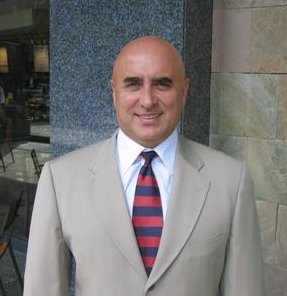
Mario Quiñones
Photo: Mario Quiñones
New York, New York – Latin Pulse recently released Latin Pulse Internet Research, a new methodology for quantitatively testing Internet marketing initiatives in Spanish in consumer products, financial services, retail and automobile campaigns. The new Internet research service is designed for marketers who want to quickly test a few ideas at a low overall cost, while obtaining results beyond those offered by traditional focus groups. Costs range between $7,000 to test a few issues and $25,000 for a comprehensive test.
The new system, touted for its projectable data, is similar to the Latin Pulse computer based testing and analysis at central locations, except the data collection methodology uses a national, representative panel of U.S. Hispanic consumers and the results are retrieved over the Internet instead of on-site. Projectable data is obtained with a statistical representative sample of the population.
Company researchers believe respondents’ opinions can be projected to the entire population with a very high degree of certainty equivalent to 90 percent. When Latin Pulse tests an ad among a Hispanic sample, their staff believe the results of the ad test will be similar in approximately 90 percent of Hispanics with similar characteristics to those in the sample.
“Researching U.S. Hispanic consumers cost effectively with projectable sample sizes has always been a major challenge for U.S. companies,” said Mario Quiñones, president, Latin Pulse. “Many tend to use focus groups instead because they are viewed as less expensive than traditional quantitative testing, although these qualitative results can be misleading and actual costs of repeated sessions often become excessive. Reaching and testing Hispanic consumers on the Internet has been a particular problem because of relatively low online incidence and difficulties of ensuring a representative sample. However, we have found the right panel to ensure sufficient Hispanic online users, while continuing to use our unique computer controlled methodology.”
The results can be delivered within six to ten days, depending on the complexity and specifics of the sample. According to a company spokesperson, Latin Pulse Internet Research offers a robust data base which reflects the real marketplace; it is quantitative and projectable; and relies on a representative national panel of Hispanic consumers with varied levels of acculturation.
“The big advantage of the Latin Pulse model for Internet testing among U.S. Hispanics is that a marketer can quickly get reliable test results on select ideas which would be projectable, validated by Latin Pulse norms, and usually less expensive than two to three focus group sessions,” said Jay Gronlund, vice president, U.S. managing director, Latin Pulse USA.
Latin Pulse is strategic market research firm headquartered in Mexico City. The company is affiliated with AcuPoll from Cincinnati, and has been using its proprietary research technology for new product concepts, advertising copy and other marketing opportunities in Latin America and the U.S. Hispanic market since 2000.
Reach Hispanics online today with
“Marketing to Hispanics Online” audio recording
Identifying and characterizing the booming Hispanic online market



Joel Bary, Alex Carvallo and Matias Perel
Find out about
• The 16 million Latino online users
• Latino online users by gender
• What they do online
• Their language preferences
• How to reach Hispanic urban youth online
• What affects their online behavior
• What influences their purchases
Click here to purchase an audio recording about marketing to Hispanics online
Posted by Elena del Valle on April 26, 2007
2007 Voz Latina Marketing to Hispanic Conference
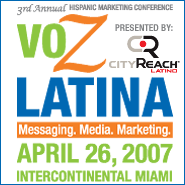
April 26, 2007 Intercontinental Miami
Now in its 3rd year, Voz Latina is the definitive Hispanic marketing conference hosted by Adweek’s Marketing y Medios, Adweek, Brandweek and Mediaweek in conjunction with the Billboard Latin Music Awards. Presentations cover online and multi-channel marketing strategies, branded entertainment, celebrity endorsements and creating ads, plus a Hispanic consumer panel, exclusive research and much more. The Hispanic Best Spots of the Year Awards will be announced at the Voz Latina Luncheon, and the first 100 registered attendees receive a complimentary all-access pass to the Billboard Latin Music Awards and pre/post VIP parties. It’s a week of learning, networking and celebrating you simply cannot miss! Speakers include:
- Jacqueline Hernandez-Fallous, Publisher, People en Español
- Lucia Ballas-Traynor, SVP, General Manager, MTV Tr3s
- Gonzalo Perez, Director, Multicultural Research and Consumer Insights, MTV Networks
- Felipe Korzenny, Ph.D., Professor and Director of the Center for Hispanic Marketing Communication, Florida State University, and Cheskin Co-Founder
- Sergio Alcocer, President / Chief Creative Officer, LatinWorks
- Thomas Schimoler, Creative Director, The Vidal Partnership
- Carlos Tornell, Creative Director, OLE
- Marcus Owenby, Director, Marketing, Cingular Wireless
- Doug Darfield, Senior Vice President, Hispanic Services, Nielsen Media Research
- Anne Howard, Director of Online Services, La Agencia de Orcí
- Greg Cunningham, Group Marketing Manager, Target
* * * Special Discount for HispanicMPR.com subscribers * * *
We have negotiated a special rate for HispanicMPR.com subscribers who want to attend the Voz Latina conference. Simply enter promo code MPR599 when you register and you will save $200 off the registration fee!
Visit http://www.marketingtohispanics.com/ or
Call 646 654 5170 or 646 654 5170
Posted by Elena del Valle on April 25, 2007
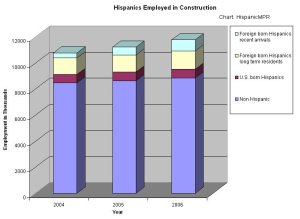
Click on image to enlarge
According to a recent Pew Hispanic Center fact sheet, two thirds of all new construction jobs went to Hispanics in 2006. In spite of a sluggish housing market, there was employment growth in the industry last year. The study leads to the conclusion that the construction industry is of great importance for foreign born and newly arrived Hispanics.
From 2005 to 2006, the Pew study indicates Hispanic employment increased by nearly one million. Latinos accounted for 36.7 percent of the increase in employment. The comparatively high share of employment reflects demographic changes in the U.S. In 2006, Latinos 16 and older accounted for 40 percent of the total increase in the working-age population.
Three of every four of these are foreign born Latino workers. At the same time, foreign-born Latinos who arrived since 2000 represented 24 percent of the total increase in employment in the U.S. labor market last year. The Pew Hispanic Center estimates indicate that about two-thirds of the increase in the employment of recently-arrived Hispanic workers is the result of illegal immigration.
In reaching its conclusions Pew staff relied on data from the Bureau of Labor Statistics and the Census Bureau. Most of the data is from the Current Population Survey, a monthly Census Bureau survey of 60,000 households.
“A Snapshot of the U.S. Hispanic Market” audio recording
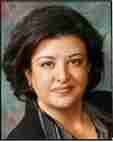
Presenter Michele Valdovinos, Phoenix Cultural Access Group
Click here to purchase “A Snapshot of the U.S. Hispanic Market”
Posted by Elena del Valle on April 24, 2007

Stephen Palacios, director, Cheskin, New York
Photo: Stephen Palacios
The Center for Marketing of New York University (NYU) will offer a two-day multicultural marketing course including several Hispanic market presentations. “Marketing to the New Majority: How to Reach the Multicultural Consumer” will take place from 9 am to 5 pm Friday, April 27 and Saturday, April 28, 2007. Three of the fourteen course presentations will be about Hispanic market topics. Registration for the non credit course costs $695.
Class Instructor Lisa Skriloff will provide an overview of multicultural market trends, the business case for diversity and discuss specific niche markets such as Hispanic, African American, Asian American, Women, Gay and Lesbian, and Disability. Skriloff is adjunct faculty member, New York University since 2001 and president, Multicultural Marketing Resources, Inc. (MMR), a public relations and marketing firm. During the course, guest speakers will share their expertise on niche markets and discuss ways to reach these groups with “traditional and innovative methods.”
“It’s a non credit class and part of our General Marketing Certificate. On average our class size is 16 to 18 students,” said Michael Browne, education advisor, School of Professional and Continuing Studies, New York University.
Stephen Palacios, director, Cheskin New York will discuss “Future Direction of the U.S. Hispanic Market: The Evolving Marketing Paradigm;” Pamela Kimmerling-Hoveling, owner, RK Hispánica Direct will talk about ”Direct Marketing to the U.S. Hispanic Market;” and Teresa Soto, president, About Marketing Solutions, Inc., will address “Right Fit Strategies, Operations and Infrastructure for Sustainable Hispanic Market Success.”
Other guest speakers for the class include: Ron Campbell, president, Campbell-Communications, Inc.; Roy Cosme, president, Arcos Communications; Saul Gitlin, executive vice president, Strategic Services, Kang & Lee Advertising; Shago Ghosh, ASB Communications; Valerie Graves, chief creative officer, Vigilante Advertising; Verdia Johnson, president, Footsteps, LLC; Andrea March, co-founder, Women’s Leadership Exchange; Laurel Van Horn, research director, Open Doors Organization; Veronica Villalpando, group director, Accounts, Latinvox; Luke Visconti, partner and cofounder, DiversityInc and Mike Wilke, founder and executive director, Commercial Closet Association.
The class is one of three required courses in the University’s five-course General Marketing Certificate. The instructor will provide grades to students based on attendance and completion of two assignments.
Target Latinos effectively by anticipating changes in the market with
“Hispanic Projections” audio recording

Presenter Roger Selbert, Ph.D.
Click here for details and to purchase an audio recording presentation by Roger Selbert, Ph.D. on “Hispanic Projections”
Posted by Elena del Valle on April 23, 2007
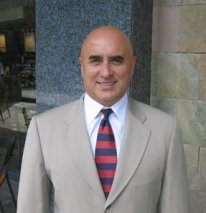
Mario Quiñones, president, Latin Pulse

Jay Gronlund, vice president and managing director, Latin Pulse USA
A podcast interview with Jay Gronlund, vice president and managing director, Latin Pulse USA, and Mario Quiñones, president, Latin Pulse is available on the Podcast Section of Hispanic Marketing & Public Relations, HispanicMPR.com. During the podcast, they discuss emotional branding to Latinos with Elena del Valle, host of the HispanicMPR.com podcast.
Jay, a marketing professional with over 30 years of senior management experience in large multinationals and in international consulting, founded The Pathfinder Group in 1990. In September 2004, the company, which specializes in business development overseas for U.S. based clients, joined forces with Latin Pulse to expand its professional capabilities in the U.S. Hispanic market.
Before starting Pathfinder, Jay was vice president and director, Marketing, Newsweek, senior vice president, Marketing and New Business, Seagram, group manager at Church & Dwight, and brand manager, Richardson-Vicks. He has a bachelor of arts from Colby College and a master of business administration degree from Tuck at Dartmouth College. Jay has been teaching a Positioning and Brand Development course at New York University since 1999.
Mario is founder and responsible for the operations of Latin Pulse since July 2000. The company has operations in Mexico, Central America, South America and the U.S Hispanic market. Mario leads the development of AcuPOLL products for Cinema testing, Car Clinics, Packaging and Advertising testing. He is also responsible for the enhancement of a new human resources product utilizing the AcuPOLL methodology.
Prior to Latin Pulse, Mario spent most of his professional career working at Proctor & Gamble in the U.S., Kraft Foods, High Life and General Mills Toy Group where he held senior marketing and management positions and was responsible for operations in Mexico and Latin America. Mario is a graduate of Texas Christian University with majors in marketing and finance.
To listen to the interview, scroll down until you see the “Podcast” on the right hand side, then select “HMPR Jay Gronlund, Mario Quinones,” click on the play button below or download the file to your iPod or MP3 player to listen on the go, in your car or at home. To download it, click on the arrow of the recording you wish to copy and save to disk. The podcast will remain listed in the April 2007 section of the podcast archive.
Click the button to hear the podcast:
Click here to sponsor a HispanicMPR.com podcast
“Emotional Branding: How to capture the heart and mind of the Hispanic consumer” audio recording


Presenters Jay Gronlund and Mario Quiñones
A presentation by Jay Gronlund and Mario Quiñones and discussion with Jay Gronlund and Mario Quiñones and HispanicMPR.com host Elena del Valle about emotional branding to Latinos.
This product consists of 104 minutes of useful insights and information by leading Latino market experts.
Available for the first time exclusively on HispanicMPR.com!
“Emotional Branding” was recorded January 2007 during the Strategic Research Institute 13th Annual Blockbuster Marketing to U.S. Hispanic and Latin America conference in Miami, Florida.
Receive a free downloadable copy by completing our Visitor Survey.
Click here
Posted by Elena del Valle on April 12, 2007
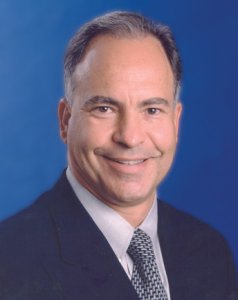
Miguel Gonzalez, vice president of Latino sales, Hy Cite
Photo: Hy Cite
Hy Cite Corporation, with the help of The San Jose Group as its Hispanic agency of record, recently launched a mid-seven figures 2007 campaign targeting Spanish dominant Latinos. It is the company’s first branding and marketing Spanish language television oriented campaign for the Royal Prestige® product line. The new 30 and 60-second ads began airing, in the first quarter of 2007, on Spanish-language networks Univision, Telemundo and Galavision.
According to a San Jose Group spokesperson, the primary target audience is Hispanic women heads of household between 18 and 49 years of age. The secondary target audience is Latino men heads of households, who marketers believe heavily influence final decisions on major purchases for the home.
A Royal Prestige starter kit, featuring a 10.5 inch skillet with cover, a 4-quart Dutch Oven with cover, an 8-inch skillet with cover and a 1.5-quart saucepan with cover costs about $1,400.
“These products are ‘the Mercedes’ of cookware,” said George L. San Jose, president and chief operating officer of the San Jose Group. “While Hy Cite has been successful at generating Hispanic sales over the years, our task will be to put a face on this brand to pre-sell the customer and make its sales force’s job even easier. We are connecting the brand and the consumer to their core purpose.”
The first execution, a 60 second spot, “Transitions,” departs from the traditional cooking demo, infomercial approach most commonly used in this category. Created with a “stylized, retro-chic” concept in mind, the spot places Royal Prestige® pots and pans center stage as glimmering props held by well coiffed women dancers who twirl and glide to a Latin beat. The commercial ends with the tagline “Cocina al Máximo” (Cook to the Max).
“We’re excited about how this marketing initiative will re-introduce our brand’s image to our consumer,” said Miguel Gonzalez, vice president of Latino sales for Hy Cite. “In the end, it will help our distributors do what they do best, which is sell.”
Hispanic customers account for 85 percent of Royal Prestige total retail sales of $260 million since 2003. At the same time, according to several online sources, numerous complaints have been filed against the company which has been sued by four states for misleading sales representations, deceptive and illegal business practices.
“Like many direct selling organizations that use independent distributors, we have faced some challenges with some of our distributors’ selling practices. However, we have taken steps to resolve this issue,” said Gonzalez. ”Last year, we became a member of the Better Business Bureau where we currently hold a satisfactory record, indicating that we have properly addressed these previous matters referred by the Bureau.”
Hy Cite, owner of the Royal Prestige® brand, is a direct marketer of cookware, kitchen items, dinnerware, fine china, juice makers, kitchen knives, and water filters. Royal Prestige® and its Health System™ cookware are touted for waterless and greaseless cooking. The San Jose Group is a consortium of marketing communications companies specializing in reaching the Hispanic and non-Hispanic markets in the U.S. and Latin America.
Reach Latinos consumers with electronic publicity tools with
“Electronic Publicity and Broadcast Public Relations” audio recording

David Henry presenter
Broadcast publicity expert David Henry shares insights drawn from years of experience to help you target Latinos effectively during this presentation and interview.
Find out how: to reach Latinos with electronic publicity; how many TV stations offer news programming in Spanish in the U.S.; which markets have the number one newscasts in Spanish; which markets offer bilingual news TV programming; and much more.
Click hereto purchase a downloadable or CD audio recording with a presentation on Electronic Publicity and Broadcast Public Relations by David Henry
Posted by Elena del Valle on April 11, 2007

Tom Rosenstiel, director, Project for Excellence in Journalism
Photo: Tom Rosenstiel
Washington, D.C. – According to “The State of the American News Media, 2007,” a new 160,000 word report on the state of journalism in America by the Project for Excellence in Journalism,(PEJ), Spanish language and other ethnic media are the only major media sectors with audience growth. The findings represent the group’s fourth annual edition.
Report contributors believe ethnic media is becoming more complex, in part because the number of foreign-language speakers has grown and spread across the country, creating new markets for ethnic outlets. Although the report points to 2006 as the first time a higher percentage of the U.S. Latino population resulted from births than from immigration; in relation to Hispanic audiences, the researchers focused on Spanish language media almost exclusively.
They theorize that predicting how U.S. born Latinos will interact with foreign-language press may be challenging, especially because they believe Spanish language and other ethnic media are less likely to have an online presence than mainstream press. At the same time, there were no salient references to English language media targeting Latinos.
“Trends that we have been tracking now for four years are reaching a pivot point,” said Tom Rosenstiel, director, Project for Excellence in Journalism. “Only one media sector, the ethnic press, is still growing, and every measurement for audience, even page views and visitors, is now being questioned. Things are now moving faster than companies can even recognize. Mainstream news media are adapting, in part, by focusing on specialties. In a sense, every outlet is becoming more of a niche player with reduced ambitions.”
One of the key findings of the study is that blogging is about to enter another phase likely to include scandal, profitability for some, and a “splintering into elites and non-elites over standards and ethics.” The researchers point out that popular bloggers are converting into businesses or being purchased by traditional media companies.
“The State of the American News Media, 2007,” is a 700-page comprehensive study of the state of U.S. journalism by PEJ, a project of the Pew Research Center in Washington, D.C. and funded by The Pew Charitable Trusts. According to promotional materials, the Project for Excellence in Journalism is a nonpartisan, non-political research group. The study was produced with the help of Rick Edmonds of the Poynter Institute, Andrew Tyndall of ADT Research and a number of industry “readers.”
The study includes detailed information on nine media sectors: newspapers, magazines, network television, cable news, local TV, the Internet (including blogs), radio, ethnic press and alternative media. For each sector, there is information on content analysis, audience, economics, ownership, newsroom investment, and public attitudes.
Discover how to reach Latinos in language today with
“Hispanic Market Translation Issues” audio recording

Presenter Martha E. Galindo
Certified translator and translation company owner Martha E. Galindo explains why it’s important to reach your clients in language to convey your message effectively. She walks you through the ins and outs of translations issues, how to select a translator, what to expect, how to save on translation costs and much more.
Click here to purchase a downloadable or CD audio recording presentation and bonus discussion on Hispanic Market Translation Issues by Martha E. Galindo






























